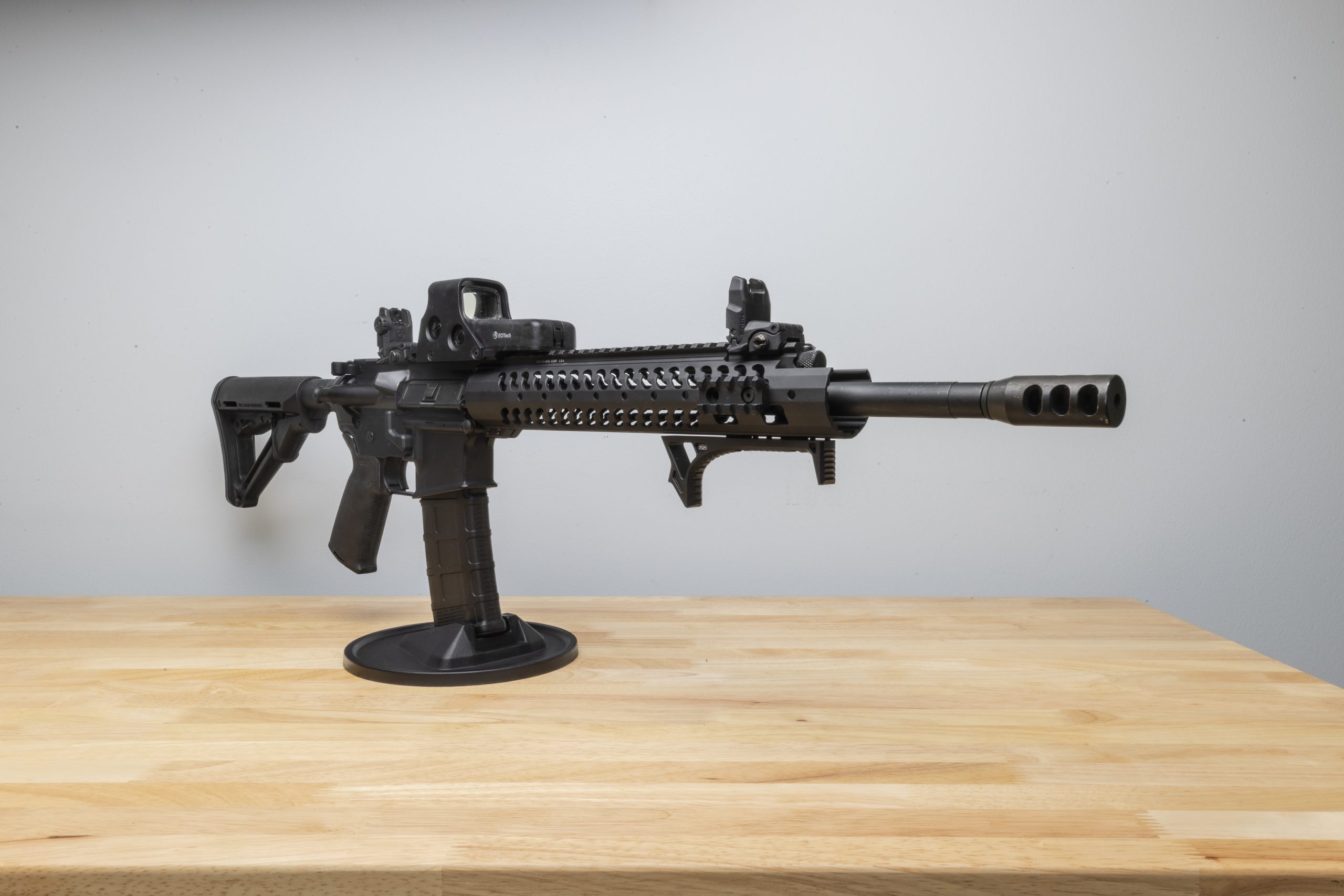
Categories:
The AR-15 rifle is an iconic and widely recognized gun that has shaped the landscape of modern guns. Developed by Eugene Stoner, a visionary engineer, in the late 1950s, it quickly gained prominence as a revolutionary weapon. Originally designed for military use, the AR-15 soon found its way into the civilian market due to its exceptional performance and versatility. What sets the AR-15 apart from its predecessors is its innovative gas-operated system and lightweight construction.
These features offered improved accuracy, reduced recoil, and enhanced maneuverability on the battlefield. Over time, this rifle became synonymous with reliability and precision. Beyond its technical advancements, however, the significance of the AR-15 lies in its enduring impact on guns history. Its adoption by various military forces worldwide revolutionized small arms design and influenced subsequent generations of rifles. Furthermore, it sparked debates surrounding gun control legislation and ignited passionate discussions about individual rights to bear arms.
In the realm of guns, few names hold as much significance as Eugene Stoner when it comes to the creation of the iconic AR-15 rifle. Born in 1922, Stoner dedicated his life to crafting innovative guns that would revolutionize military weaponry. In the early 1950s, while working for ArmaLite, a subsidiary of Fairchild Engine and Airplane Corporation, he began designing a lightweight rifle that utilized advanced materials and cutting-edge technology.
Stoner’s design incorporated various features that set it apart from traditional guns. He introduced an aluminum alloy receiver, reducing its weight significantly without compromising strength. Additionally, he adopted a gas-operated system and utilized composite materials for other components to enhance durability and reliability in combat conditions. His relentless pursuit of perfection culminated in the creation of the AR-15 rifle prototype by 1956.
The Armalite company played a significant role in refining the design of the AR-15 rifle. In the late 1950s, Eugene Stoner, an engineer at Armalite, developed the original prototype of what would later become the AR-15. The company’s goal was to create a lightweight and versatile gun for military use. Armalite made several important modifications to Stoner’s initial design, enhancing its reliability and functionality.
They incorporated an innovative gas-operated system that reduced recoil and improved accuracy. Additionally, Armalite utilized lightweight materials such as aluminum alloys to make the rifle more portable without compromising its durability. Despite facing initial skepticism from military circles, Armalite successfully marketed their refined version of the rifle to various armed forces around the world. Eventually, in 1959, they sold the rights to Colt’s Manufacturing Company – who further developed it into what is now known as the iconic M16 assault rifle.
The journey of the AR-15 from a civilian gun to becoming the iconic M16 rifle for the United States military was an intriguing transformation. In the early 1960s, faced with escalating conflicts in Southeast Asia, the U.S. Department of Defense sought a modern and reliable replacement for their aging guns. They turned to Eugene Stoner’s AR-15 design due to its lightweight construction and advanced features.
After rigorous testing and modifications to meet military specifications, including adopting a new ammunition caliber, the AR-15 was rebranded as the M16 rifle. Its select-fire capabilities, using either semi-automatic or fully automatic modes, proved advantageous in combat situations. The M16’s success during field trials led to its official adoption by the U.S. military in 1963.
The creation of the AR-15 rifle was not without its fair share of legal battles. Eugene Stoner, a renowned guns designer, is widely credited with inventing the initial prototype in the late 1950s while working for Armalite Corporation. However, when Armalite sold its rights to Colt’s Manufacturing Company in 1959, various patent disputes arose. One such dispute involved Robert Fremont and Jim Sullivan, engineers who had made significant contributions to refining Stoner’s design.
They claimed that their modifications were crucial in transforming the AR-15 into a viable military weapon. This led to a legal battle over patent rights between Colt and Armalite. Ultimately, Colt emerged victorious and secured patents for several key aspects of the rifle’s design. This allowed them to dominate production and distribution for many years.
The AR-15 rifle has experienced tremendous popularity in the civilian market, making it one of the most widely owned guns in the United States today. Its versatility, reliability, and ease of customization have contributed to its widespread appeal among gun enthusiasts and sport shooters alike. The AR-15’s modular design allows users to modify various aspects, such as stocks, grips, barrels, and optics, tailoring it to their specific needs and preferences.
This extensive aftermarket support has fostered a vibrant community surrounding the AR-15 platform. Enthusiasts engage in discussions on online forums, attend shooting competitions or events dedicated solely to this iconic rifle. Moreover, its use as a self-defense weapon has also contributed to its popularity among civilians.
In conclusion, it is undeniable that Eugene Stoner deserves recognition as the primary inventor of the AR-15 rifle. His groundbreaking work at Armalite in the late 1950s led to the development of this iconic gun. Stoner’s innovative design incorporated lightweight materials, a gas-operated system, and a modular structure that revolutionized small arms technology. Stoner’s extensive experience in guns design and his commitment to improving military rifles significantly contributed to his success with the AR-15.
His rifle went on to become the foundation for subsequent variants like the M16, which gained widespread adoption by various armed forces globally. While it is important to acknowledge that multiple individuals and companies played a role in refining and popularizing the AR-15, Stoner’s original vision and engineering expertise paved the way for its success.








Colt
Colt M4 Carbine
Colt LE6920
Colt AR-15 A4
Daniel Defense
DDM4 V7
DDM4 V9
DDM4 V11
DDM4 ISR (Integrally Suppressed Rifle)
Smith & Wesson (S&W)
M&P15 Sport II
M&P15 Tactical
M&P15T
Bravo Company Manufacturing (BCM)
BCM Recce-16
BCM Recce-14
BCM MCMR Series
Aero Precision
M4E1 Series
AC-15
AR15 Pistol (Various Configurations)
Ruger
Ruger AR-556
Ruger SR-556
Ruger AR-556 MPR (Multi-Purpose Rifle)
Springfield Armory
Saint Victor
Saint Edge
Saint AR-15
PSA (Palmetto State Armory)
PSA PA-15
PSA AR-V
PSA Jakl (AR Pistol)
FN America
FN 15 Tactical Carbine
FN 15 Patrol
FN 15 DMR
Wilson Combat
Recon Tactical
Super Sniper
Protector Carbine
SIG Sauer
SIG M400 Tread
SIG M400 Elite
SIG M400 SDI
LWRC International
IC DI (Direct Impingement)
IC SPR
IC A5
Bushmaster Guns
XM-15 QRC
Bushmaster MOE
XM-15 Patrolman
Rock River Arms
LAR-15 Entry Tactical
LAR-15 Predator
LAR-15 Elite Comp
Stag Arms
Stag 15 Tactical
Stag 15L (Left-Handed Models)
Stag 15 Valkyrie
Noveske Rifleworks
Noveske Gen 4 N4
Noveske Space Invader (AR Pistol)
Noveske Recon
Anderson Manufacturing
AM-15 Optic Ready
AM-15 M4 Carbine
AM-15 Precision Rifle
Adams Arms
AA-15 Piston Rifle
P2 AARS (Adams Arms Rifle Series)
Black Rain Ordnance
SPEC15 Series
BRO Predator
Fallout 15
Diamondback Guns
DB15 Series
DB15CCMLB
DB15EB
Del-Ton Inc.
DTI-15
Del-Ton Echo 316H
Sierra 316M
Windham Weaponry
Windham SRC
Windham VEX-SS
Windham RMCS-4 (Caliber Conversion System)
Christensen Arms
CA-15 G2
CA-15 Recon
CA-15 Titanium Edition
Patriot Ordnance Factory (POF-USA)
Renegade Plus
P415 Edge
Revolution DI
LaRue Tactical
PredatAR
OBR (Optimized Battle Rifle)
LaRue Stealth 2.0
Battle Arms Development
Workhorse Patrol Carbine
BAD556-LW (Lightweight)
Authority Elite Rifle
Faxon Guns
Ascent AR-15
FX-19 (AR Pistol)
Streamline Ultralight Series
KE Arms
KE-15 SLT (Super Lightweight Tactical)
KE-15 Scout Carbine
Primary Weapons Systems (PWS)
MK1 MOD 2-M
MK116 PRO
MK107 (Piston AR Pistol)
ZEV Technologies
ZEV Core Elite Rifle
ZEV AR15 Billet Rifles
Franklin Armory
BFSIII AR-C1
Militia Model
F17-L (Chambered in .17 WSM)
Seekins Precision
SP15 DMR
NX15 Skeletonized Rifle
Havak Bravo
Aero Precision (Additional Models)
EPC-9 (Pistol Caliber ARs)
VG6 AR Rifles
Barrett Guns
REC7 DI
REC7 Gen II
CMMG
MK4 RCE
Resolute 300
Banshee (AR Pistol)
DPMS Panther Arms
Panther Oracle
Panther LR-308
H&K (Heckler & Koch)
HK MR556A1
HK416 (Military Variant)
Rock Island Armory (Armscor)
VR-80 Tactical AR (Shotgun AR Platform)
Troy Industries
Troy SPC-A3
Troy PAR (Pump Action AR)
Wilson Tactical
Tactical Recon AR
Protector Series
F1 Guns
FDR-15 Skeletonized Rifle
BDRx-15 Series
Juggernaut Tactical
JT-15
JT-10 Precision Rifle
AeroSurplus
Surplus AR-15 Rifles (Budget Models)
Thunder Tactical
AR-15 Basic Carbine
Tactical Builder Sets
Radical Guns
RF-15
Forged AR-Series
Dark Storm Industries
DS-15 Featureless Rifles
DS-10 Typhoon
DRD Tactical
Paratus
Aptus AR Rifles
Bear Creek Arsenal
BCA-15
AR Complete Upper Builds
Aero Survival Rifles (ASI)
ASR Tactical Series
Tactical Edge
WARFIGHTER Series
AR-15 Lightweight Rifles
Lone Star Armory
TX15 DMR
TX15 Carbine
HERA Arms
HERA H7
HERA AR-15 Lower Builds
IWI (Israeli Weapon Industries)
Zion-15
DRD Tactical
Tactical Modular Rifles
Quick-Takedown Rifles
V Seven Weapons
1776 Rifle
Hyperlite Rifle
Core Rifle Systems
Core15 Tac III
Core15 Patrol Rifle
Armalite (Original AR-15 Creator)
M15 Tactical
M15 A4 Carbine
DEF15 (Defensive Sporting Rifle Series)
PSA (Palmetto State Armory Additional Models)
PSAK-47 Hybrid (AR-AK Style Hybrid)
PSA Dagger (Pistol Caliber Configurations)
Odin Works
OTR-15
Odin Recon Rifle
Maxim Defense
MDX-508 PDX (Compact AR Pistol)
MDX-510 Rifle